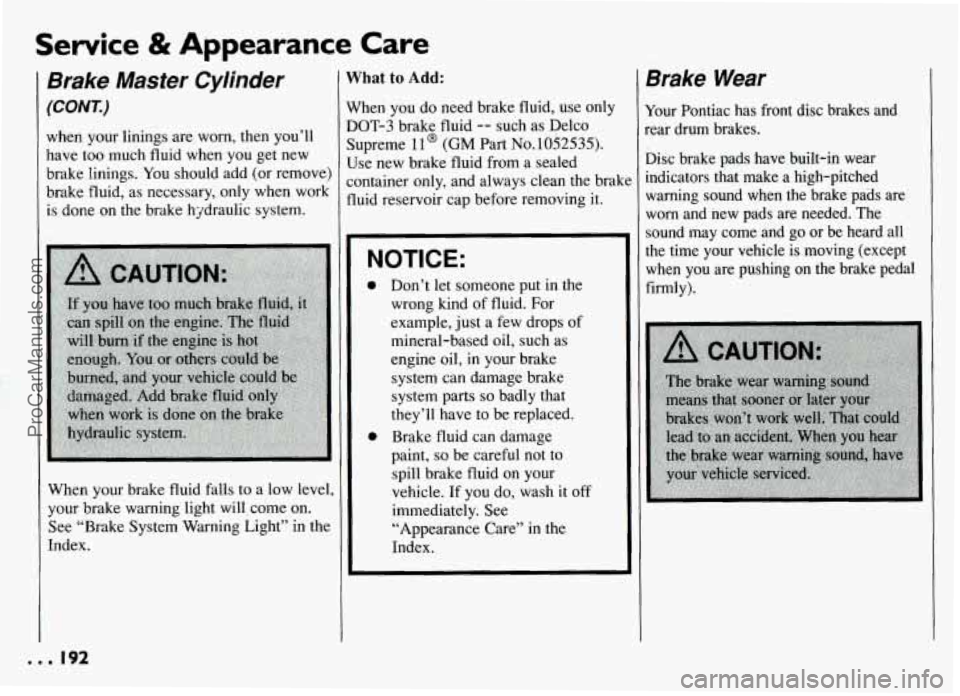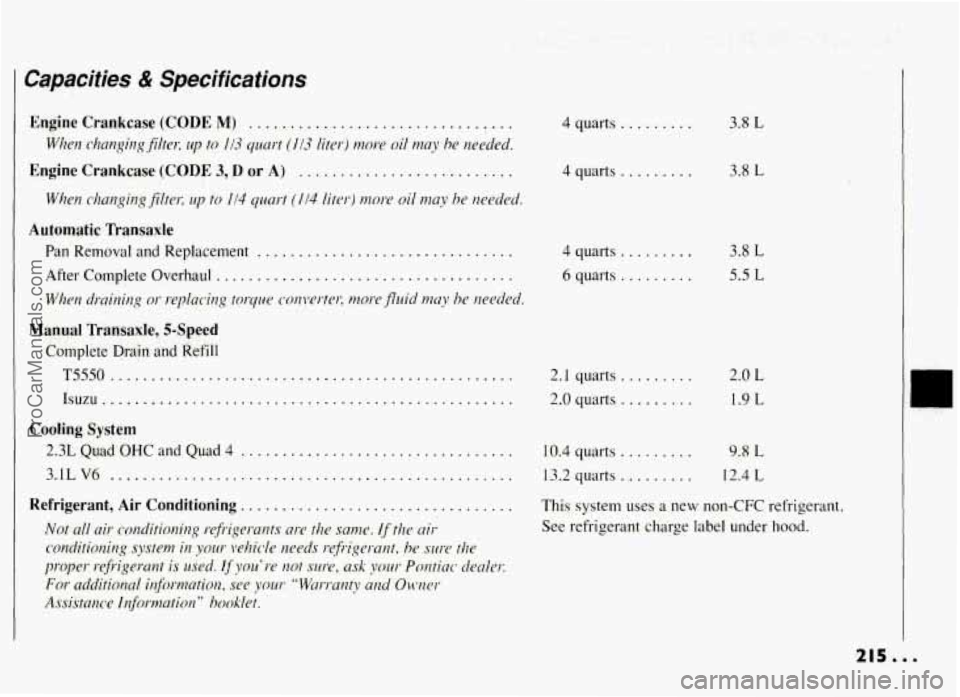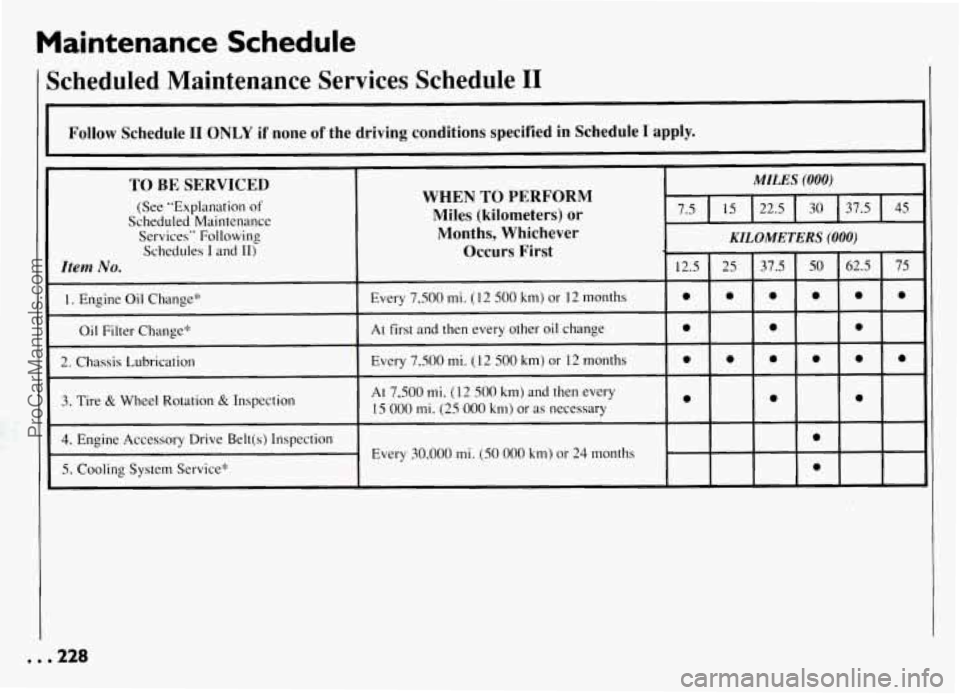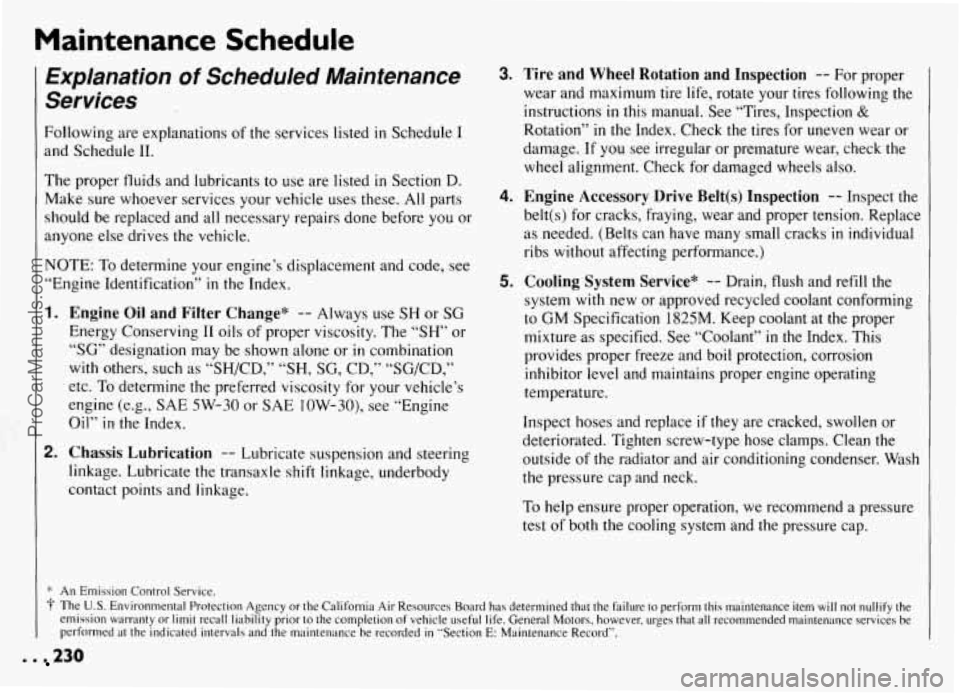1994 PONTIAC GRAND-AM engine oil
[x] Cancel search: engine oilPage 187 of 274

I Service & Appearance Care
Manual Transaxle
Fluid
When to Check
A good time to have it checked is when
the engine
oil is changed. However, the
tluid
in your manual transaxle doesn't
require changing.
How to Check
Because this operation can be a little
diftlcult,
you may choose to have this done
at a Pontiac Dealership Service Department.
If you do it yourself, be sure to follow a11
the instructions here, or you could get a
false reading on the dipstick.
NOTICE:
Too much or too little tluid can
darnage
your transaxle. Too much
can mean that some
of the tluid
could come out and fall
011 hot
engine parts or exhaust system,
starting a fire. Be sure
to get an
accurate reading
if you check your
transaxle fluid.
Check the tluid level only when your
engine IS off. the vehicle is parked on a
level place and the transaxle is
cool
enough for you to rest your fingers on the
transaxle case.
I
hen, Follow These Steps:
I Flip the handle up and the.n pull out
the dipstick and clean it with a rag or
paper towel.
2. Push it back in all the way and remove
It.
3. Check both sides of the dipstick and
read the lower level. The fluid level
must be between the
ADD and FULL
marks. (Note: Fluid may appear at the
bottom
of the dipstick even when the
tluid level is several pints low.)
4. If the tluid level is where it should be,
push the dipstick back in all the way
and flip the handle down. If the fluid
level is low. add more fluid as
described
in the next steps.
. .* 186
ProCarManuals.com
Page 189 of 274

Service & Appearance Care
How to Check:
The proper fluid should be added if the
level is at or below the STEP mark on the
reservoir cap. See the instructions on the
reservoir cap.
Engine Coolant
The following explains your cooling
system and how to add coolant when
it is
low.
If you have a problem with engine
overheating, see “Engine Overheating”
in
the Index,
The proper coolant for your Pontiac will:
Give freezing protection down to
-34°F (-37°C).
Give boiling protection up to 262°F
( 128 “C).
Protect against rust and corrosion.
Help keep the proper engine
temperature.
Let the warning lights work as they
should.
What to Use
Use a mixture of one-half clean water
(preferably distilled) and one-half
antifreeze that meets “GM Specification
1825-M,” which won’t damage aluminum
parts.
You can also use a recycled coolant
conforming to GM Specification 1825-M
with a complete coolant flush and refill. If
you use this mixture, you don’t need to
add anything else. NOTICE:
If you use an improper coolant mix,
your engine could overheat and be
badly damaged. The repair cost
wouldn’t be covered by your
warranty. Too much water
in the
mix can freeze and crack the engine,
radiator, heater core and other parts.
... 188
ProCarManuals.com
Page 193 of 274

Service & Appearance Care
Brake Master Cylinder
(CONT.)
when your linings are worn, then you’ll
have too much fluid when you get new
brake linings. You should add (or remove)
brake fluid, as necessary, only when work
is done on the brake hydraulic system.
When your brake fluid falls to a low level.
your brake warning light wil1,come on.
See “Brake System Warning Light” in the
Index.
What to Add:
When you do need brake fluid, use only
DOT-3 brake fluid -- such as Delco
Supreme
11 @ (GM Part No. 1052535).
Use new brake fluid from a sealed
:ontainer only, and always clean the brak
fluid reservoir cap before removing it.
NOTICE:
e
0
Don’t let someone put in the
wrong kind
of fluid. For
example, just a few drops
of
mineral-based oil, such as
engine oil, in your brake
system can damage brake
system parts
so badly that
they’ll have to be replaced.
Brake fluid can damage
paint,
so be careful not to
spill brake fluid on your
vehicle. If you
do, wash it off
immediately. See
“Appearance Care” in the
Index.
3rake Wear
‘our Pontiac has front disc brakes and
ear drum brakes.
Xsc brake pads have built-in wear
ndicators that make a high-pitched
varning sound when the brake pads are
vorn and new pads are needed. The
ound may come and
go or be heard all
he time your vehicle is moving (except
when you are pushing on the brake pedal
irmly).
ProCarManuals.com
Page 216 of 274

4quarts .........
4 quarts ......... 3.8 L
6 quarts ......... 5.5 L
Capacities & Specifications
Engine Crankcase (CODE M) ................................ 4 quarts ......... 3.8 L
When changing filter; up to /I3 quart (113 liter) more oil may he needed.
Engine Crankcase (CODE 3, D or A) ........................ . 3.8 L
When changing filter; up to 114 quart (114 liter) more oil may be needed.
Automatic Transaxle
Pan Removal and Replacement ...............................
After Complete Overhaul ....................................
When draining or ~-eplat*ing torque conl~erte~; more fluid may be needed.
Manual Transaxle, 5-Speed
Complete Drain and Refill
T5550 ................................................. 2.1 quarts ......... 2.0 L
Isuzu .................................................. 2.0quarts ......... 1.9 L
Cooling System
2.3L Quad OHC and Quad 4 ................................. 10.4 quarts ......... 9.8 L
3.1L V6 ................................................. 13.2 quarts. ......... 12.4 L
Refrigerant, Air Conditioning. ................................ This system uses a new non-CFC refrigerant.
Not all air conditioning refrigerants are the same. If the air See refrigerant charge label under hood.
conditioning system in your rvhic-le needs re$-igerant, he suse the
proper refrigerant is used. If you’re not sure, ask your Pontiac dealer,
For additional info)-mation, see your “Warranty and 0wwc.r
Assistance Information’’ hooklet.
215...
ProCarManuals.com
Page 221 of 274

Service & Appearance Care
Normal Maintenance Replacement Parts
Air Cleaner Element
2.3L Quad OHC and Quad 4 ....................
3.lLV6 ....................................
Engine Oil Filter
2.3L Quad OHC and Quad 4 ....................
3.1LV6 ....................................
PCV Valve
3.1LV6 ....................................
Spark Plugs
2.3L Quad OHC ..............................
2.3L Quad DOHC with Automatic Transaxle .......
2.3L Quad DOHC with Manual Transaxle .........
2.3L Quad High Output ........................
3.1LV6 ....................................
AC Type A- 1233C
AC Type A-1233C
AC Type PF- 1225
AC Type PF-40
or AC Type PF-47
AC Type 892C
AC Type 041-603
Gap: 0.035 inch (.889 mm)
AC Type 04 1-603
Gap: 0.035 inch (.889
mm)
AC Type 041-602
Gap: 0.035 inch (389 mm)
AC Type 04 1-602
Gap: 0.035 inch
(.889 mm)
AC Type R44 LT SM6
Gap: 0.060 inch (1.52 mm)
... 220
ProCarManuals.com
Page 229 of 274

Maintenance Schedule
Scheduled Maintenance Services Schedule I1
Follow Schedule I1 ONLY if none of the driving conditions specified in Schedule I apply.
I
TO BE SERVICED
(See "Explanation of
Scheduled Maintenance Services" Following Miles (kilometers) or
Months, Whichever
KILOMETERS (000)
MILES (000)
WHEN TO PERFORM
Schedules I and 11,- Occurs First
Item No. 37.5 25
12.5
1. Engine Oil Change" Every
7,500 mi. ( 12 500 km) or 12 months
0,il Filter Change"
2. Chassis Lubrication At
first and then every other oil change
Every 7,500 mi. (12
500 km) or 12 months
0 0 0
0 0
0 0
0
3. Tire & Wheel Rotation & Inspection
4. Engine Accessory Drive Belt(s) Inspection
5. Cooling System Service*
At 7,500 mi. ( 12 500 km) and then every
15
000 mi. (25 000 km) or as necessary 0 0
Every 30.000 mi. (50 000 km) or 24 months
!
+
50 62.5
1
I
I.
t
. . .22a
ProCarManuals.com
Page 231 of 274

Maintenance Schedule
Explanation of Scheduled Maintenance
Services
Following are explanations of the services listed in Schedule I
and Schedule 11.
The proper fluids and lubricants to use are listed in Section D.
Make sure whoever services your vehicle uses these. All parts
should be replaced and all necessary repairs done before you or
anyone else drives the vehicle.
NOTE: To determine your engine’s displacement and code, see
“Engine Identification”
in the Index.
1.
2.
Engine Oil and Filter Change* -- Always use SH or SG
Energy Conserving I1 oils of proper viscosity. The “SH” or
“SG” designation may be shown alone or in combination
with others, such as “SH/CD,” “SH, SG, CD,” “SG/CD,”
etc. To determine the preferred viscosity for your vehicle’s
engine (e.g., SAE 5W-30 or SAE 10W-30), see “Engine
Oil”
in the Index.
Chassis Lubrication -- Lubricate suspension and steering
linkage. Lubricate the transaxle shift linkage, underbody
contact points and linkage.
3.
4.
5.
Tire and Wheel Rotation and Inspection -- For proper
wear and maximum tire life, rotate your tires following the
instructions
in this manual. See “Tires, Inspection &
Rotation” in the Index. Check the tires for uneven wear or
damage. If you see irregular or premature wear, check the
wheel alignment, Check for damaged wheels also.
Engine Accessory Drive Belt(s) Inspection -- Inspect the
belt(s) for cracks, fraying, wear and proper tension. Replace
as needed. (Belts can have many small cracks
in individual
ribs without affecting performance.)
Cooling System Service* -- Drain, flush and refill the
system with new or approved recycled coolant conforming
to
GM Specification 1825M. Keep coolant at the proper
mixture as specified. See “Coolant”
in the Index. This
provides proper freeze and boil protection, corrosion
inhibitor level and maintains proper engine operating
temperature.
Inspect hoses and replace if they are cracked, swollen or
deteriorated. Tighten screw-type hose clamps. Clean the
outside of the radiator and air conditioning condenser. Wash
the pressure cap and neck.
To help ensure proper operation, we recommend a pressure
test of both the cooling system and the pressure cap.
. . 230
ProCarManuals.com
Page 232 of 274

6. Transaxle Service -- For manual transaxles, fluid doesn’t
require changing. See “Periodic Maintenance Inspections.”
For automatic transaxles, change both the fluid and filter
every
15,000 miles (25 000 km) if the vehicle is mainly
driven under one or more of these conditions:
* In heavy city traffic where the outside temperature
regularly reaches 90°F (32°C) or higher.
0 In hilly or mountainous terrain.
0 When doing frequent trailer towing.
0 Uses such as found in taxi, police car or delivery
service.
If you -do not use your vehicle under any of these
conditions, change both the fluid and filter every
100,000 miles ( 166 000 km).
7. Spark Plug Replacement* -- Replace spark plugs with
the proper type. See “Replacement Parts” in the Index.
8. Spark Plug Wire Inspection (3.1L Code M engine
only)*?
-- Inspect for burns, cracks or other damage.
Check
the boot fit at the coils and at the spark plugs.
Replace wires as needed.
9. Air Cleaner Filter Replacement* -- Replace every
30,000 miles (50 000 km) or more often under dusty
conditions.
Ask your dealer for the proper replacement
intervals for your driving conditions.
1 O.Fuel Tank, Cap and Lines Inspection”? -- Inspect fuel
tank, cap and
lines (including fuel rails and injection
assembly) for damage or leaks. Inspect
fuel cap gasket for
an even filler neck imprint or any damage. Replace parts as
needed. Periodic replacement of the fuel filter is
not
required.
* An Emission Control Service.
3- The U.S. Environmental Protection Agency or the California Air Resources Board has determined that the failure to perform this maintenance item will not nullify the
emission warranty or limit recall liability prior to the completion of vehicle useful life. General Motors, however, urges that all recommended maintenance services be performed at the indicated intervals and the maintenance be recorded in “Section E: Maintenance Record”.
ProCarManuals.com